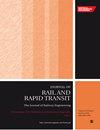铁路混凝土板加载模式的数值研究
IF 2.1
4区 工程技术
Q3 ENGINEERING, CIVIL
Proceedings of the Institution of Mechanical Engineers Part F-Journal of Rail and Rapid Transit
Pub Date : 2024-08-27
DOI:10.1177/09544097241277577
引用次数: 0
摘要
尽管近来无砟轨道的建造量激增,但与这些轨道类型相关的轨座荷载(RSL)研究仍存在明显差距。RSL 是指从钢轨传递到紧固系统、钢轨下面的钢板和钢轨垫的荷载。有砟轨道系统的 RSL 预测已得到广泛研究,但对无砟铁路轨道系统的研究相对缺乏。本文采用二维有限元模型(2D FEM)来评估有关有效参数的 RSL,包括轨枕间距、紧固系统刚度和钢轨的弯曲模量。研究中进行的现场测试对数值模型进行了验证。此外,还提出了一个数学表达式来确定混凝土板轨道的 RSL 比率。RSL 与轨枕间距和紧固刚度直接相关,而与抗弯刚度的关系是反向的。结果发现,传统方法得出的 RSL 比率与所提出的数学表达式有很大差异。更具体地说,除了 0.68 米和 5 MN.m2 之外,Kerr 模型中几乎所有的轨枕间距和钢轨抗弯刚度值都存在这种差异。本文章由计算机程序翻译,如有差异,请以英文原文为准。
Numerical investigation on loading pattern of railway concrete slabs
Despite the recent surge in the construction of ballastless railway tracks, there exists a notable research gap concerning the rail seat load (RSL) associated with these track types. The RSL is the load transferred from the rail to the fastening system, the plate beneath the rail and the rail pad. The prediction of RSL in ballasted track systems is widely investigated, however, there has been a relative lack of research into the ballastless railway track systems. In this paper, a 2D finite element model (2D FEM) was adopted to evaluate the RSL concerning the effective parameters, including sleeper spacing, fastening system stiffness and the flexural modulus of the rail. The numerical model was validated through a field test performed in the study. Moreover, a mathematical expression was proposed to determine the RSL ratio for concrete slab tracks. The RSL directly correlates with the sleeper spacing and the fastening stiffness, while this relation with the flexural rigidity is inverse. Based on the results, it was found that the RSL ratio obtained from the conventional methods differed considerably from the proposed mathematical expression. More specifically, this difference was observed in almost all of the values in the sleeper spacing and flexural rigidity of rail for the Kerr model except 0.68 m and 5 MN.m2 , respectively.
求助全文
通过发布文献求助,成功后即可免费获取论文全文。
去求助
来源期刊

CiteScore
4.80
自引率
10.00%
发文量
91
审稿时长
7 months
期刊介绍:
The Journal of Rail and Rapid Transit is devoted to engineering in its widest interpretation applicable to rail and rapid transit. The Journal aims to promote sharing of technical knowledge, ideas and experience between engineers and researchers working in the railway field.
 求助内容:
求助内容: 应助结果提醒方式:
应助结果提醒方式:


